What to Wear Skiing & Snowboarding - How to Dress & Layer
It’s easy to get caught up in the hype of exciting new snowboards and groundbreaking ski boots, but the biggest thing you can do to make your skiing or snowboarding experience better is to dial in how you dress for a day on the slopes. And for beginners just getting started, it’s even more important to be properly prepared - letting you focus on fun and learning rather than how cold or uncomfortable you are. Conditions on the mountain can change fast in the mountains and you need to be prepared for anything from high winds and freezing sleet to sun and slush. So we’ve put together this guide to help explain the higher level concepts behind why we dress like we do in the mountains, as well as giving specific guidelines and examples of how to best dress for a day on the hill.
When you’re dressing for skiing or snowboarding, it’s important to start out with a good base, then build up your layers depending on the conditions. The three main things your ski outfit needs to deal with are cold, wind, and moisture, both coming from the outside in the form of snow or rain, and from the inside in the form of perspiration. Skiing and snowboarding gear and clothing can be expensive, luckily, you might already have some layers in your closet that you can wear. Follow along and we’ll help you pick out the perfect layers that will help you stay warm and comfortable out on the mountain.
How to Layer Clothing for Skiing & Snowboarding
The most important thing to remember when you’re figuring out what to wear skiing or snowboarding for the first time is that layering is the most efficient way to keep you warm and dry, and it also allows you to adapt your kit on the fly to changing weather conditions. Most people dress for skiing & snowboarding in three main layers, a base layer, mid layer, and shell. Each with their own important function.
Once you’ve got your basic layering system figured out, it’s time to embrace the magic of modularity. You don’t have to wear all your layers all the time, instead you can swap them out to make sure you’re comfortable no matter the conditions. So if it’s warm out, but still snowing on the hill, you can ditch your insulating layer and just ski in a shell and base layer. Or, if it’s calm and cold, but isn’t precipitating, you can leave your shell in the lodge and ride in your base layer and insulating layer.
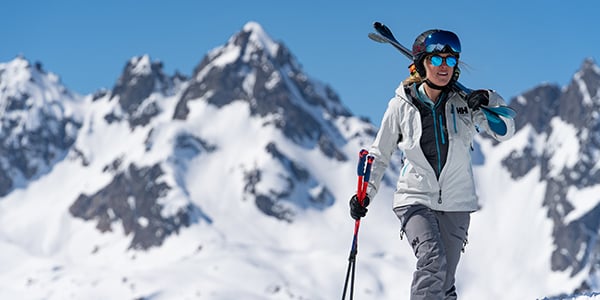
Layering can work the other direction too, you can double up insulating layers on cold days for extra warmth, while still using the same shell and base layers. The key is staying flexible and adapting, think of the layering system as ingredients to a recipe, every day you can look at what the weather is doing and tweak that recipe to keep you comfortable and dry.
Ski & Snowboard Base Layers
Your base layer is what you wear next to your skin. Taking the name literally, it sets the base of everything else you’re going to put on before you get on the chairlift. It starts with your underwear, and the long underwear that you wear over it, as well as a long sleeved top. The primary goal of ski & snowboard base layers is to protect you from the moisture of your own perspiration. When you’re active, your body sweats to cool you down. Even though its cold when you ski & board, you will sweat - it’s just the nature of sports. So, it’s important that your base layer is able to wick that moisture away from your skin before it makes you cold or clammy.
The best ski and snowboard baselayers are explicitly designed to wick moisture away from your body. This is often achieved by choosing the right type of fabric, typically synthetic or wool. You don’t need a ski-specific base layer, any comfortable, wicking long sleeve athletic top and tights will work. The big thing to avoid with base layers is cotton. Cotton doesn’t wick moisture away from you, instead it just lets that moisture sit on your skin and make you cold. So look for wicking long johns and a long sleeved top. They don’t need to be thick and warm, just wicking and comfortable. Don’t wear a sweatshirt or sweatpants, they’re too bulky to fit under your other layers and won’t manage moisture well.
Do You Wear Underwear Under Your Ski & Snowboard Base Layers?
As for the underwear you wear skiing and snowboarding, the choice is yours. Some skiers and snowboarders prefer not to wear underwear underneath base layers, while some prefer the support and comfort that undergarments can provide. The same guidelines apply to underwear as baselayers - look for materials that are moisture-wicking and not cotton.
What Socks do You Wear Skiing or Snowboarding?
The socks you choose to wear skiing or snowboarding are one of the most important parts of your kit - we recommend investing in specific ski or snowboard socks that are thin and moisture- wicking. Your socks will not only dictate how warm your feet stay, but also how comfortable your boots would be. One of the biggest mistakes beginners make is choosing the wrong socks.
Ski and snowboard specific socks have a couple of important properties - they wick moisture, they are thin, and they fit tightly. First, like other baselayers, they’re made out of materials that pull moisture away from your skin and insulate while wet. Next, and perhaps most counterintuitive is thickness. Thinner socks allow for better circulation, keeping your feet warmer. Finally ski and snowboard socks are tightly fitted so that they do not bunch up in your boots.
While it’s not absolutely necessary to buy ski or snowboard-specific socks, it can be difficult to find this trio of properties elsewhere. So, we recommend investing in a good pair of thin wool or synthetic ski or snowboard socks - there’s nothing that can ruin a day faster than cold or uncomfortable feet. For more info read our guide to choosing ski & snowboard socks.
Ski & Snowboard Mid Layers & Insulation
The next layer up is your insulating layer. This layer’s whole goal is to deal with the cold and keep you warm. So it doesn’t need to be waterproof, or wick water away from you, it just needs to have insulation that will trap air and keep you warm. Your ski or snowboarding mid layer is also your most adjustable layer. Did it warm up over the day? You can switch to a thinner mid layer, or take it off altogether. Chilly out there on the mountain? Throw on the extra fleece you brought.
If you own a puffy down or synthetic jacket, you’ve already got an insulating layer. Some folks like to use sweaters or fleeces as their insulating layers, too, though they can be more bulky. It’s still a good idea to avoid cotton here, as your insulating layer can get wet.
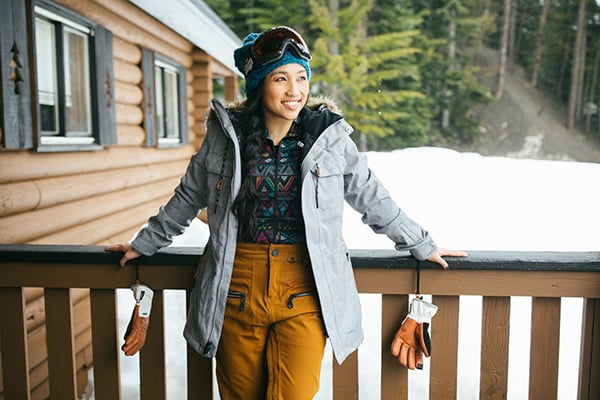
Most skiers and snowboarders just need an insulating layer on the top half of their body, a puffy jacket does the job perfectly. However, if you find your legs getting cold, there are down and synthetic insulated puffy knicker pants available to keep your legs warm.
When you’re shopping for your insulating layer you’ll have two main options: down or synthetic insulation. Down offers the best warmth to weight ratio, it keeps you really warm while staying light and packable. But, when down gets wet, it doesn’t do a good job keeping you warm. Synthetic insulation doesn’t quite deliver quite as much warmth per gram as down, but if it gets wet it will keep working. So if you live in a relatively dry climate, down might be the right choice for you, but if you’re somewhere that’s warm and wet, like the PNW, a synthetic layer is a good call.
Look for something that fits comfortably over your base layer but isn’t so bulky that you have a hard time fitting your shell over it. Likewise, make sure that your insulating layer isn’t too tight - and doesn’t restrict your movement.
Ski & Snowboard Shell Jackets, Pants & Bibs
The final piece to dressing for skiing or snowboarding and your outside layer is the shell. This is what comes to mind when you picture a ski or snowboard jacket, and snow pants. This is the most expensive layer, thanks to all of the technology that goes into making them waterproof AND breathable, but it’s also the most important in keeping you protected from the elements.
Ski & snowboard shell jackets & pants have two jobs: they protect you from moisture coming from the outside in the form of snow or rain, and it protects you from the cold that gusts of wind bring. In addition, nice shells will also “breathe” - allowing vapor to get away from your body without letting any moisture or wind in. This works in tandem with your base layer to get sweat away from you, and keep you nice and dry. There are three main ways that jackets & pants are rated - by their waterproofing, breathability, and insulation.
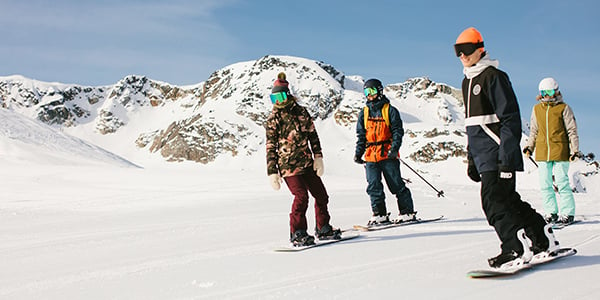
The higher the rating the more waterproof or breathable a jacket is. So a jacket with a waterproofing of 30K and a breathability of 30K is more waterproof and breathable than one rated 10k/10k. In general, look for shells with both waterproofing and breathability ratings between 10k and 30k. If you live in a wetter climate like the PNW, you’ll want to opt for the higher end of the range for better protection. It’s impossible to be too waterproof, but prices do tend to increase significantly for more waterproof jackets. Want to learn more about these ratings? Read our guide to waterproof and breathability ratings.
Ski & snowboard jackets are either insulated, or just simple shell jackets. Both are great options with their own pros and cons. Shell jackets let you better control your temperature by layering under them. Conversely, you can't remove the insulation from a jacket - this means that insulated ski & snowboard jackets might let you get away without a mid layer, but they're less flexible especially on warmer days.
We think it’s worth buying skiing and snowboarding-specific shells - they make a huge difference on the hill, they last for a long time, and you can use them to stay dry in the rain or snow, even when you’re not skiing. That said you can get away with other types of shell jackets. We recommend jackets that are both waterproof and breathable even if it’s not snowing out. If you fall down, or the weather changes, you can still get wet.
Ski & Snowboard Bibs vs Pants
Ski & snowboard pants follow the same guidelines as shells, but offer one additional choice - bibs versus pants. Choosing between these two types of snow pants falls largely to preference, but there are a couple of important distinctions. Bibs stay up more easily without a belt, and better protect your backside from wet and cold snow. Bibs can also be more comfortable and warmer, since they don’t have a waistband and have more material over your core. One drawback of bibs, especially for women, is that it can be more difficult to answer nature’s call - yes we mean going to the bathroom. Thankfully gear manufacturers have answered our calls, designing clever workarounds like butt-flap zippers, and halter-style bibs.
What Gloves or Mittens to Wear Skiing & Snowboarding?
Cold hands are no fun - so keeping your hands warm and dry is serious business. Choosing between gloves and mittens is all about tradeoffs. Mittens offer the most warmth, but the least dexterity - it’s harder to pull out your phone, adjust your goggles, or grab a zipper. Gloves have the opposite properties - more maneuverability, but less warmth. There are some hybrid styles, too, that have only some fingers combined into a mitt. These offer the best of both worlds. Likewise, you can add warmth and dexterity to mittens by adding a liner glove. This means you can slip off your larger mitts to do detailed tasks, while still retaining some warmth and protection.
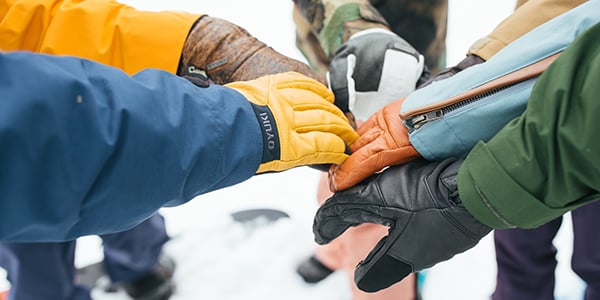
As with other ski clothing and gear, it’s important to consider both warm and waterproofing. Ski & snowboard gloves and mittens will often feature waterproof fabrics like GORE-TEX or treated leather so they stay dry. So, sure, it’s possible to wear other types of gloves on the mountain, but make sure that they’re both waterproof and insulated. You may see folks on the mountain wearing what look like normal leather work gloves, but they’re almost always treated with a waterproofing wax.
Should you Wear a Helmet or Hat Skiing & Snowboarding?
If you’re going skiing or snowboarding, you should wear a helmet. You never expect to crash, and when you do it’s rarely in the safest and softest way possible - plus there are many other factors on the mountain that are out of your control. Modern ski and snowboard helmets are light, comfortable, and do a really good job of protecting your brain.
The first key to choosing a ski or snowboard helmet is fit. Helmets are sized by a traditional Small-Large sizing. If you’re not sure what size ski or snowboard helmet you need, you can measure your head and reference a size chart. Most ski or snowboard helmets come with an internal fit system that helps dial in the specifics. Fit with your goggles is another important factor. Less focused on safety and more on comfort, you want to make sure that there are no gaps between your goggles and helmet, and that your helmet doesn’t push your goggles down into your nose or face. You may need to adjust your goggle strap for optimal fit.
Aside from fit, the other important aspects of ski and snowboard helmets are advanced safety technologies like MIPS, weight, and audio integration. Each of these additional features can add significantly to cost, but give you plenty of options to find the right helmet for you.
Skiing or Snowboarding Hats & Face Masks
While ski and snowboard helmets do a pretty good job of keeping your head warm, it’s not a bad idea to wear a light liner beanie underneath. It will keep your head warmer and more comfortable in the helmet. Just make sure it doesn’t have any big seams, a pom pom, or a cuff that could interfere with your helmet. Alternately, you can wear a combination mask and hat, like a balaclava that keeps your head and face warm.
Finally, you’re going to want some kind of buff or face mask that allows you to pull it up over your mouth and nose to stay warm, or pull it down around your neck to cool you down and allow you to breathe easier. Even if you don’t like riding with a ski or snowboard face mask covering your mouth, these masks do a good job of closing any gaps between your jacket and your helmet, keeping heat from escaping around your neck.
Should you Wear Goggles or Sunglasses Skiing & Snowboarding?
While riding in sunglasses can be fun, we recommend ski & snowboard goggles - they’re better at protecting your face and eyes from sun and wind. That said, it’s nice to bring a pair of sunglasses with you to the mountain for the drive, or for hanging out on the patio for some apres snacks and beverages.
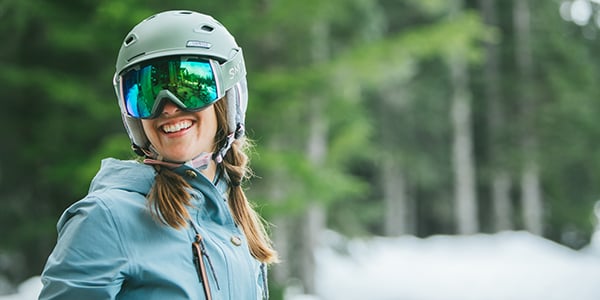
The key to finding good ski or snowboard goggles is to make sure they work with the shape of your helmet and the shape of your face. That’s why it’s a good idea to always try them on with your helmet before you buy, to make sure that the helmet doesn’t push them down over your nose, or leave a big gap on your forehead. Many goggles will come with two lenses, one for sunny days, and one for overcast and foggy days. It’s a good idea to practice swapping those lenses out at home so you know how they work and can do it quickly on the hill. And always bring both lenses up to the mountain, weather can change quickly and you’re not going to have a good day skiing if you can’t see.
Adjusting to Different Temperatures
Sure, it’s easy to lay out the basics here and suggest a solid layering system, but what do you actually want to wear out of the house? We’ve broken down a few scenarios here to help you choose what to wear skiing or snowboarding by temperature and weather.
What to Wear Skiing & Snowboarding in Cold Weather
When you’re figuring out what to wear skiing or snowboarding on cold days, we’re talking anywhere below 15 degrees, it’s important to add some extra warmth. This means something like, a base layer, a fleece or sweater, a puffy jacket, then your shell on top. It’s important to think about your hands, feet, and face, too. So now is the time to bring out the warm gloves, and definitely a face mask. Resist the urge to add extra or ticker socks, as they will cut off the circulation in your feet and actually make them colder.
What to Wear Skiing & Snowboarding in Warm Weather
When the sunshine hits and the slush is firing you can drop some clothes and enjoy the breeze. While you may see folks riding in boardshorts and bikinis we still recommend cover up to protect from the sun and from snow burn if you fall - snow crystals are rather sharp and can cut up your skin. So, for warmer days, it’s a good idea to ditch your mid layer, just wearing a base layer and shell. If it’s really warm you may be able to ride comfortably in just a base layer, but remember, it will feel windy as you’re ripping around the mountain at speed, and that can make it chilly. Sticking to the theme of covering up, it’s always a good idea to keep your gloves or mittens on, even if they’re just liners, to protect you from the snow. A face mask is also a good idea to shield you from the bright sun that also reflects off the snow for a double-whammy.
What to Wear Skiing & Snowboarding By Location
While you may think you need a new kit for your next ski or snowboard trip. What you wear skiing & snowboarding in Canada isn’t any different than what you wear skiing & snowboarding in Utah or Colorado. If you’re traveling to a new location to ride it's important to do your research and fall back on the versatility of layers. Maybe you’re traveling to Mt. Baker, where the powder is deep, the snow is more wet, and temperatures are more mild. On this trip you might want to focus on your waterproof shell layer rather than packing a lot of mid layers for warmth. Conversely, a mid-winter trip to Banff would necessitate some extra layer so you can bundle up.
Learn More With Our Other Outerwear & Layering Guides:
What to Wear Skiing & Snowboarding
How to Choose a Ski & Snowboard Jacket
How to Choose Ski & Snowboard Pants
Jacket Fit & Length Guide
How to Choose Outerwear by Region
How to Dress for Backcountry Skiing & Snowboarding
Waterproof Ratings & Breathability Guide
Outerwear Construction, Fabric & Features
How to Choose Base Layers & Long Underwear
How to Choose Insulated Clothing
GORE-TEX® Fabric - How it Works & Product Testing